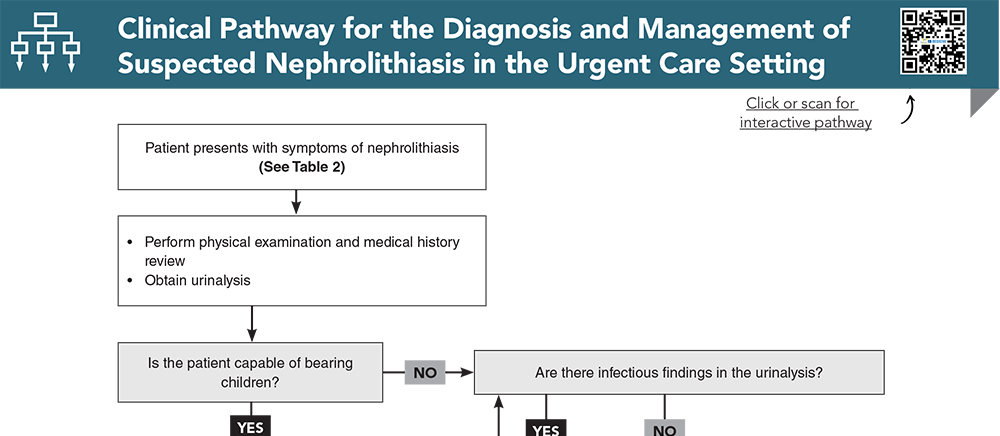

The incidence of nephrolithiasis has been increasing in recent years, making it a common presenting condition in the urgent care. The clinical presentation of nephrolithiasis is variable and overlaps with other serious medical conditions, so urgent care clinicians must be able to identify the condition and be familiar with evidence-based recommendations for evaluation and treatment. This article reviews the pathogenesis, symptomatology, initial diagnostic workup, and current medical management of this condition in the urgent care setting. It also reviews clinical scenarios in which patients with nephrolithiasis should be emergently referred for specialty care.
How would you manage these patients? Subscribe for evidence-based best practices and to discover the outcomes.

Buy this issue and
Subscribe to access the complete Clinical Pathway to guide your clinical decision making.
Buy this issue and
Following are the most informative references cited in this paper, as determined by the authors.
16. * Wong C, Teitge B, Ross M, et al. The accuracy and prognostic value of point-of-care ultrasound for nephrolithiasis in the emergency department: a systematic review and meta-analysis. Acad Emerg Med. 2018;25(6):684-698. (Systematic review and meta-analysis; 5 studies, 1773 patients) DOI: 10.1111/acem.13388
17. * Rodger F, Roditi G, Aboumarzouk OM. Diagnostic accuracy of low and ultra-low dose CT for identification of urinary tract stones: a systematic review. Urol Int. 2018;100(4):375-385. (Systematic review; 12 studies, 1529 patients) DOI: 10.1159/000488062
19. * Smith-Bindman R, Aubin C, Bailitz J, et al. Ultrasonography versus computed tomography for suspected nephrolithiasis. N Engl J Med. 2014;371(12):1100-1110. (Comparative effectiveness; 2759 patients) DOI: 10.1056/NEJMoa1404446
25. * Garcia-Perdomo HA, Echeverria-Garcia F, Lopez H, et al. Pharmacologic interventions to treat renal colic pain in acute stone episodes: Systematic review and meta-analysis. Prog Urol. 2017;27(12):654-665. (Systematic review and meta-analysis; 9 studies, 3852 patients) DOI: 10.1016/j.purol.2017.05.011
29. * Pathan SA, Mitra B, Cameron PA. A systematic review and meta-analysis comparing the efficacy of nonsteroidal anti-inflammatory drugs, opioids, and paracetamol in the treatment of acute renal colic. Eur Urol. 2018;73(4):583-595. (Systematic review; 36 studies, 4887 patients) DOI: 10.1016/j.eururo.2017.11.001
31. * Raison N, Ahmed K, Brunckhorst O, et al. Alpha blockers in the management of ureteric lithiasis: a meta-analysis. Int J Clin Pract. 2017;71(1). (Systematic review and meta-analysis; 67 studies, 6654 patients) DOI: 10.1111/ijcp.12917
33. * Wang H, Man LB, Huang GL, et al. Comparative efficacy of tamsulosin versus nifedipine for distal ureteral calculi: a meta-analysis. Drug Des Devel Ther. 2016;10:1257-1265. (Meta-analysis; 12 studies, 4961 patients) DOI: 10.2147/DDDT.S99330
35. * Pickard R, Starr K, MacLennan G, et al. Medical expulsive therapy in adults with ureteric colic: a multicentre, randomised, placebo-controlled trial. Lancet. 2015;386(9991):341-349. (Randomized control trial; 1167 patients) DOI: 10.1016/S0140-6736(15)60933-3
41. * Pickard R, Starr K, MacLennan G, et al. Use of drug therapy in the management of symptomatic ureteric stones in hospitalised adults: a multicentre, placebo-controlled, randomised controlled trial and cost-effectiveness analysis of a calcium channel blocker (nifedipine) and an alpha-blocker (tamsulosin) (the SUSPEND trial). Health Technol Assess. 2015;19(63):vii-viii, 1-171. (Randomized control trial; 1167 patients) DOI: 10.3310/hta19630
42. * Meltzer AC, Burrows PK, Wolfson AB, et al. Effect of tamsulosin on passage of symptomatic ureteral stones: a randomized clinical trial. JAMA Intern Med. 2018;178(8):1051-1057. (Randomized control trial; 512 patients) DOI: 10.1001/jamainternmed.2018.2259
Subscribe to get the full list of 45 references and see how the authors distilled all of the evidence into a concise, clinically relevant, practical resource.
Keywords: kidney stones, nephrolithiasis, kidney stone disease, renal colic, renal calculi, medical expulsive therapy, nonsteroidal anti-inflammatory drugs, flank pain, urinalysis, hematuria, urology, kidney stone imaging
Raigan A. Burkall-Lewis, MD
Lisa M. Campanella-Coppo, MD, FACEP; Ivan Koay, MBChB, MRCS, FRNZCUC, MD
January 1, 2025
January 1, 2028 CME Information
4 AMA PRA Category 1 Credits™. 4 AOA Category 2-B Credits. 4 AAFP Prescribed Credits